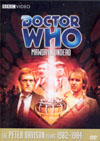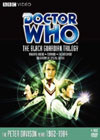DVD Extras include:
The Doctor's initial plot strand with Nyssa and Tegan is not grand or riveting, but will do. Their first scene spends much time (unnecessarily?) explaining events of the previous story "Snakedance". I suppose this is alright if one is watching the entire season in order, but for those watching this story on its own, or as the first in a trilogy box set, it's all a lengthy, confusing, meaningless bit, as well as a spoiler for something they may not have seen yet. And when continuity is too tight like this, it neglects to leave space in between televised stories for other adventures that exist only in the viewers' imaginations. Sad. The original introduction to the TARDIS was not great for this story, throwing in a single shot of the police box materializing in an unfamiliar place, and then cutting away and back before showing our trio coming out of it, but at least the prior scene in the console room delivered a proper set-up for the effect. This sequence was also the most obvious candidate for CGI improvement in the entire story. Nicely the CGI team added entirely new shots to the sequence, making the TARDIS a little easier to understand for first time viewers. And because of the way the TARDIS is used in this adventure, it is doubtful that any viewer will come to the end of it not understanding its basic properties. Using some trademark humour and perhaps a bit too much hasty running around, the major characters embark on a bit of exploration. While these scenes are okay and do intrigue, other stories have provided stronger lines of exploration, and it is difficult to tell where the example of it in this story is going. In many respects, these portions of the story are being overshadowed by other things.
First ImpressionsHaving only seen the first three Key to Time stories before getting into season 18 and beyond, I was over the moon to finally see the Black Guardian appear in a Doctor Who story. This was the villain I'd been waiting for. The much-criticized bird on the head of his costume didn't bother me at all, as it provided a logical link to much of the dialogue in "The Stones of Blood" (story no. 100), and anyway, the wonderful Valentine Dyall gives such a strong and powerful performance as the Guardian that it was a long time before I even noticed it. Mark Strickson throws a lot into his performance as Turlough, and together the two make a uniquely sinister and frightening pair.Episode one ends without really explaining Nicholas Courtney's character. Was this the same Brigadier from the Jon Pertwee era that I'd read about in novelizations of stories like "Inferno" (story no. 54)? One of his stated beliefs seemed to indicate that he was not. But in the end, this is a fair quandary to leave us in for a week, because episode two becomes a really strong and enjoyable exploration of the Brigadier, his life, and a peculiar event in his past. We also get yet another successful JNT era flashback sequence, and quite a satisfying one to boot. On top of that comes more very successful editing for the 80's during this episode, as cuts between our two major plot strands often serve two functions at once with many helpful and logical links in the dialogue. One of the most beautifully written continuing juxtapositions in all of Doctor Who! Successful sections like this help us excuse many other sequences where scenes are too short and cuts between separate parts of the story are too frequent, because at least we have by then a better sense of who the characters are and what they want to achieve. And it's only when David Collings' character finally reveals his name to the audience, that one can begin to make sense of the story's bizarre title. A lot is required of Collings in order to make his character work within the story and create the right amount of uncertainty in our protagonists, and he seems to do a wonderful job of getting everything just right, elevating suspense, and being appropriately weird and sympathetic all at the same time. Nice.
The backstory for this adventure delves into the series' mythology, and this is critical for understanding the unfolding plot and the danger. I think it is good that this story follows "Arc of Infinity" (story no. 124) in the season, because images from that story can come to mind and help make better sense of what gets talked about here. Nice. Paddy Kingsland returns to create the music for this story, and provides it with an enjoyable, effective, and solid backing. While several of the most major heavy themes are very similar, simple, and repeat maybe just a bit too often, these are interspersed with some lighter, fun cues that give the score more variety and a good emotional range. The theme for the Brigadier / school is particularly enjoyable, while the cue for the flashback sequence cleverly plays off of the Doctor Who theme itself and is recognizably unique within the score, instantly evoking nostalgia even for those of us who hadn't yet seen any of the old clips featured in the sequence. Transmat is back for this adventure, now employing nifty looking capsules achieved with satisfying dissolve effects and appropriate sound. This is a uniquely Whovian element of the story, featuring prominently as it should. The capsule interior is a bit jarring, and could have used a proper introductory scene, with someone commenting on its design. Having an interior helps solve certain production challenges though. There still seems to be a hole or two in the plot logic concerning the capsules, but of course this is the kind of spoiler I always save for the in-depth analysis versions of my reviews. This story is perhaps also unique for this period of Doctor Who in having almost no violence anywhere in it, particularly during the conclusion. There is still a lot of tension built up towards the climax, and a lot of that is due to Valentine Dyall's insistence that things are drawing to a critical point, a lot is at stake, and things may yet go a number of different ways. The Doctor's character is put in a unique position at the end, and he has to make a difficult decision. Peter Davison plays the part very well during this sequence. .....And I'll save the rest of my discussion of this for the in-depth analysis version of this review.
This story is available on DVD as the first adventure of the Black Guardian Trilogy. Click on the Amazon symbol for the location nearest you for pricing and availability:
Comments on this article are welcome. You may contact the author from this page:
|









